|
|
|
Reviews and Observations on
Silent Westerns
by Boyd Magers |
As the forerunner of the sound westerns we all enjoy, the silent westerns that still exist deserve our consideration and attention. As seemed to be the custom of the day, you’ll notice in silents many of the cowboy heroes mix light comedy with hard action. This style was carried over into talkies primarily by Hoot Gibson, but to a lesser degree by Ken Maynard and Buck Jones, eventually giving way to straight action from the star of the film with the comedy elements left to the sidekicks (Gabby, Fuzzy, Smiley, etc.) Silent westerns also exhibited stronger roles for women and usually more romance than in the sound era B-westerns.
For specific stars or titles, use your "Find on this page" feature on your computer.
The
Ratings |
|
|
Average
 
|
Very little of Interest

|
Not Worth
your time!

|
Posted 3/19/11
   SQUARE DEAL MAN (1917) 43 minutes SQUARE DEAL MAN (1917) 43 minutes
Originally released in 1917, “Square Deal Man” was one of the William S. Hart features which found its way to former Triangle president Stephen A. Lynch after Triangle collapsed in 1918-1919. Lynch, owner of a large southern theatre chain, then reissued a slightly edited version which is what now exists.   Called a parasite by preacher Milton Ross, gambler William S. Hart at first shrugs off the insult, but begins to reassess his lot in life after he wins everything in a high stakes poker game from Col. J. Frank Burke, including his vast rancho. Burke calls Hart a cheat, the room goes dark, shots are fired and Hart believes he has killed the rancher. Disgusted with his present life, believing he is truly a “parasite”, Hart and his pal Joseph J. Dowling, take charge of the ranch he won from Burke (along the way they even “adopt” an orphan baby). Learning of her father’s death, the Colonel’s daughter, Mary McIvor, arrives from the East. Not realizing the circumstances of her father’s demise, or that Hart “owns” the rancho, McIvor installs Hart as her range boss and treats him like a hired servant. It’s soon learned a crooked ranch hand, Darrel Foss, was the man who actually shot and killed the Colonel during the darkened melee and now, aided by a band of rustlers, tries to secure the rancho for himself. Foss lies to McIvor, telling her Hart murdered her father. Furious, she fires Hart and makes Foss her foreman, but Hart and Dowling vow not to leave the naïve McIvor in the clutches of the outlaw. With the aid of a group of rangers, Foss and the rustlers are disbanded and McIvor learns the truth of her father’s death. Bill, tearing up the deed he won at poker, joins Mary as half-owner of the vast rancho as they plan to wed. Called a parasite by preacher Milton Ross, gambler William S. Hart at first shrugs off the insult, but begins to reassess his lot in life after he wins everything in a high stakes poker game from Col. J. Frank Burke, including his vast rancho. Burke calls Hart a cheat, the room goes dark, shots are fired and Hart believes he has killed the rancher. Disgusted with his present life, believing he is truly a “parasite”, Hart and his pal Joseph J. Dowling, take charge of the ranch he won from Burke (along the way they even “adopt” an orphan baby). Learning of her father’s death, the Colonel’s daughter, Mary McIvor, arrives from the East. Not realizing the circumstances of her father’s demise, or that Hart “owns” the rancho, McIvor installs Hart as her range boss and treats him like a hired servant. It’s soon learned a crooked ranch hand, Darrel Foss, was the man who actually shot and killed the Colonel during the darkened melee and now, aided by a band of rustlers, tries to secure the rancho for himself. Foss lies to McIvor, telling her Hart murdered her father. Furious, she fires Hart and makes Foss her foreman, but Hart and Dowling vow not to leave the naïve McIvor in the clutches of the outlaw. With the aid of a group of rangers, Foss and the rustlers are disbanded and McIvor learns the truth of her father’s death. Bill, tearing up the deed he won at poker, joins Mary as half-owner of the vast rancho as they plan to wed.
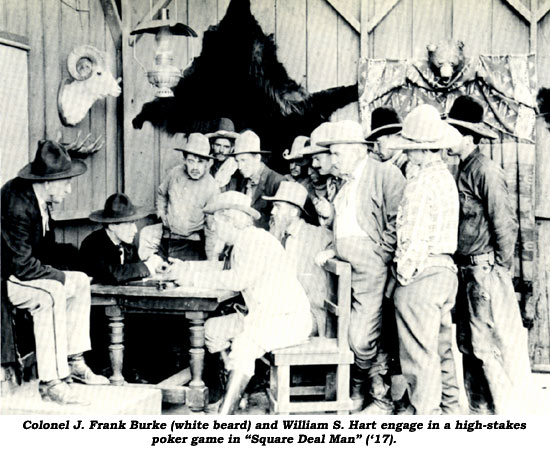
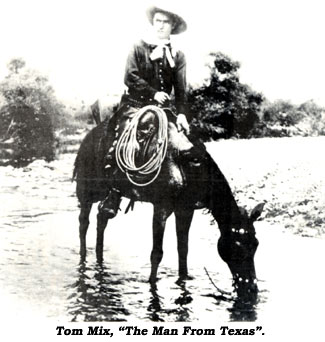    MAN FROM TEXAS (1920s Aywon) 40 minutes MAN FROM TEXAS (1920s Aywon) 40 minutes
This “version” of “Man From Texas” is a compilation by Aywon of three Tom Mix Selig one-reelers from 1914-1915, all co-starring Goldie Colwell, with the dialogue cards changed in the latter two to reflect the screen names used in the original “Man From Texas” (1915) which is the first film in this compilation. In this one-reeler Tom Mix seeks out the un-scrupulous gambler (E. J. Brady) who caused the death of his sister (Louella Maxam). Along with way Tom falls in love with Goldie Colwell, another girl upon whom Brady has forced his attentions. The second 12 minutes is taken from “Forked Trails” (1915) in which Tom rescues Goldie from Mexican bandidos. We finish off with “Sheriff’s Reward” (1914). Now a sheriff, Mix rescues Goldie, now a ranch owner, from a band of cattle rustlers led by Leo Maloney. Watch for a young Hoot Gibson as a member of the posse.
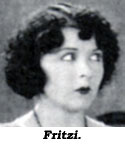   A WOMAN’S VENGEANCE (1920 Capital Film) 17 minutes A WOMAN’S VENGEANCE (1920 Capital Film) 17 minutes
When T. C. Jack and his gang jump a mining claim belonging to Fritzi Ridgeway’s father, Fritzi takes the law into her own hands, straps on a gun and goes after the gang. She even manages to rescue her lover, Bob Burns, from the gang’s drowning trap.   Born in Missoula, MT, in 1898, the 5'5", 120 lb., brown-haired, blue-eyed, tomboyish Fritzi entered films in 1917. She and Bob Burns (also born in Montana, in 1884) made 14-15 two-reelers for Capital in 1920-‘21. Fritzi also co-starred in westerns with Roy Stewart, Harry Carey, Fred Church and Tom Mix. She died of a heart attack at 62 in 1961. Born in Missoula, MT, in 1898, the 5'5", 120 lb., brown-haired, blue-eyed, tomboyish Fritzi entered films in 1917. She and Bob Burns (also born in Montana, in 1884) made 14-15 two-reelers for Capital in 1920-‘21. Fritzi also co-starred in westerns with Roy Stewart, Harry Carey, Fred Church and Tom Mix. She died of a heart attack at 62 in 1961.
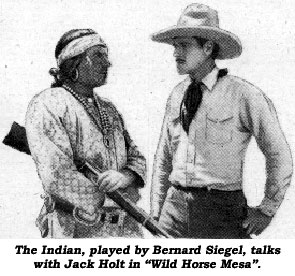   WILD HORSE MESA (1925 Paramount) 94 minutes WILD HORSE MESA (1925 Paramount) 94 minutes
Anything-for-a-buck George Magrill wrangles storekeeper George Irving into a scheme to round-up a wild horse herd by driving them into a barbed wire corral in the desert. Learning of their vicious, inhuman plan, Jack Holt steps up to convince them otherwise. Irving backs out of the deal, but Magrill hooks up with Noah Beery’s outlaw bunch to complete the trap. As the outlaws stampede the horses toward the wire, Holt diverts the herd in the nick of time. Beery is killed in the finale by the Indian father of a girl Beery had earlier molested. Based on a Zane Grey story, the first half drags but recovers in the exciting second half. A bit of prudent editing of many scenes would have given the film a better pace.
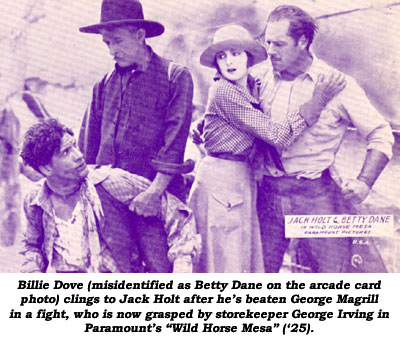
   TEXAS STREAK, THE (1926 Universal) 51½ minutes TEXAS STREAK, THE (1926 Universal) 51½ minutes
Bounced off the prop truck heading back to town from location, flat busted movie extra Hoot Gibson and his two pals (Slim Summerville and Jack Curtis), with nothing but bluff, con a power and water company into believing Hoot is the wild and woolly two gun Texas Streak so he can be hired as a company troubleshooter. Seems James Marcus, owner of the largest ranch the power company must survey and cross or soon lose its permit, is being bamboozled by nefarious Alan Roscoe, turning the ranchers against the power company and blocking its progress. While playing guard for the new power company, Hooter is smitten by Marcus’ daughter Blance Mehaffey and eventually discovers Roscoe is secretly working for a competing company.
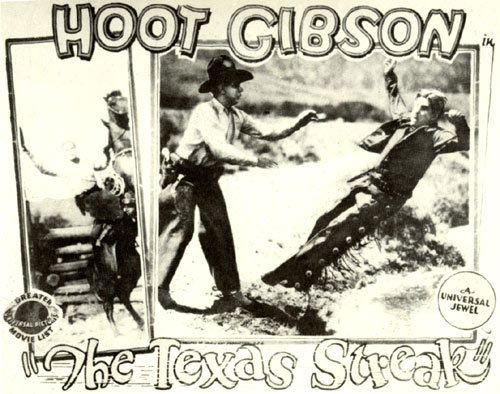
Posted 1/24/11
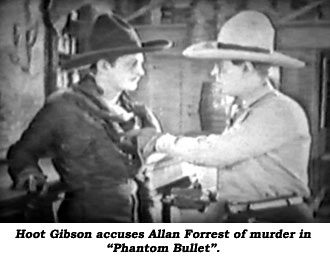    PHANTOM BULLET (1926 Universal) 57 minutes PHANTOM BULLET (1926 Universal) 57 minutes
Hoot Gibson poses as Percy, a happy-go-lucky camera buff dude, and uses his love of photography to expose the murderer of his rancher father. Turns out to be ranch foreman Allan Forrest who is in cahoots with rustler Pat Harmon; the pair are secretly driving all the cattle off the ranch. Watch for Pee Wee Holmes as one of the ranch hands. As most of Hoot’s westerns do, this plays up the light comic moments, but it certainly features a thrill packed windup.
  THE FUGITIVE (1910 Biograph) 17 minutes THE FUGITIVE (1910 Biograph) 17 minutes
D. W. Griffith short depicting the tragedy of war. In the North a Union solider named John (Edwin August) leaves home to fight in the Civil War while at the same time in the South a Confederate soldier named John prepares to do the same. In a hard fought battle the Union solider kills the Rebel. Being chased by Confederate soldiers, he coincidentally takes refuge in the home of the mother (Kate Bruce) of the boy he has slain.
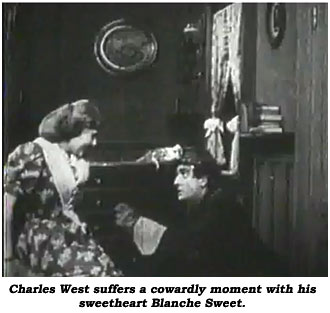   THE BATTLE (911 Biograph) 11 minutes THE BATTLE (911 Biograph) 11 minutes
Civil War Union soldiers fight a raging battle just outside Blanche Sweet’s home. Her lover, Charles West, at first faces a cowardly moment but his later heroism saves the day when he brings much needed ammunition to his trapped comrades. Watch for a young Lionel Barrymore as a wagon driver and Donald Crisp as a Union soldier. Excellently staged battle scenes from director D. W. Griffith.
    THE LAST DROP OF WATER (1911 Biograph) 13 minutes THE LAST DROP OF WATER (1911 Biograph) 13 minutes
Of her two suitors, Blanche Sweet rejects a good man (Robert Harron) and marries drunken lout Charles West just before a wagon
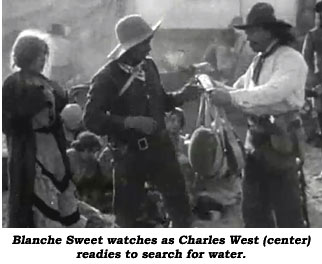 train of settlers heads west. In the desert, attacked by Indians and their water nearly gone, West redeems himself by trying to slip past the warring Indians in search of water but loses his life just as the Cavalry arrives. Based on a Bret Harte story, director D. W. Griffith’s short film displays stunning production values for its time with a cast of hundreds. ^ ^ Charles West, born in Pittsburgh in 1885, had stage experience before entering films in 1909 with Griffith’s Biograph company. He died at 57 in 1943. train of settlers heads west. In the desert, attacked by Indians and their water nearly gone, West redeems himself by trying to slip past the warring Indians in search of water but loses his life just as the Cavalry arrives. Based on a Bret Harte story, director D. W. Griffith’s short film displays stunning production values for its time with a cast of hundreds. ^ ^ Charles West, born in Pittsburgh in 1885, had stage experience before entering films in 1909 with Griffith’s Biograph company. He died at 57 in 1943.
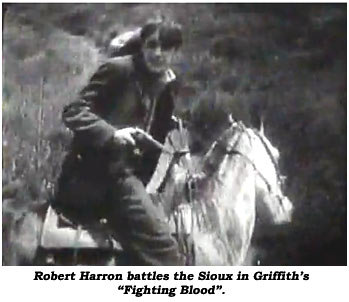    FIGHTING BLOOD (1911 Biograph) 11 minutes FIGHTING BLOOD (1911 Biograph) 11 minutes
Cavalry corporal Robert Harron goes AWOL but returns in the middle of an Indian attack and brings help to rout the Sioux. Reportedly based on a Zane Grey story, this one-reeler is considered by some film historians to be one of director D. W. Griffith’s best dramatizations of an Indian attack, an incident he used in various forms in several short films. Watch for a young Lionel Barrymore as a fighter inside the settler’s cabin. ^ ^ NYC born Robert Harron began his acting career as a teenager in 1907 with D. W. Griffith. His promising life and career were cut short at 27 when he died of an accidental gunshot wound in 1920. ^ Lionel Barrymore (1878-1954) was a Broadway star by 1900 and entered films in 1907 with D. W. Griffith where his work included some 14 western shorts. In the ‘40s a hip injury and arthritis forced him to act from a wheelchair.
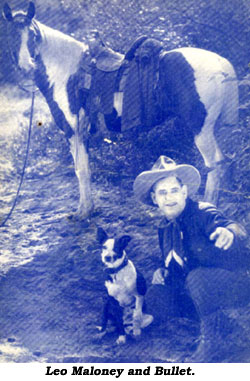   PERFECT ALIBI (1924 William Steiner) 60 minutes PERFECT ALIBI (1924 William Steiner) 60 minutes
Plans for marriage between Ranger Leo Maloney and Josephine Hill, daughter of Maloney’s Ranger Captain (Indian actor Chief White Horse), are disrupted when Hill’s brother, Earl Close, is framed for robbery and murder by the real badmen—Tom London (still billed under his real name Leonard Clapham) and Jim Corey. Maloney finds Close’s gun near the dead man’s body, but to protect the kid, he and Hill refuse to tell the Ranger Captain they believe his own son is guilty. Eventually, the “perfect alibi” of the two outlaws is exposed and Close is cleared. Drama takes precedent over action in this Ford Beebe directed tale. Prominently featured is Maloney’s dog Bullet who Maloney found as a stray in 1923 while he was doing some target shooting. After being trained, Bullet was featured in Maloney’s films.
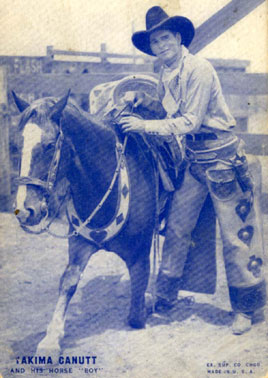   THE IRON RIDER (1927 Goodwill) 63 minutes THE IRON RIDER (1927 Goodwill) 63 minutes
Hoping to make a big pile so he can marry his girl, Elsa Benham, Yakima Canutt is snookered in a poker game by card sharp Jim Corey and his cohort Lee Sepulveda. Yak loses not only his dough but his horse Boy. Informed he was cheated by down-and-out ex-con Nelson McDowell who served time with Corey and Sepulveda, Yak quickly mounts Boy and dashes out of town. Learning there is a reward for Corey, Sepulveda and their third pal Al Hewston, Yak rides back into town to collect the reward so he and Elsa can get married. An overlong card game sequence drags the picture midway, but Yak redeems all with a big saloon battle and chase at the end. Still, even with several trick riding scenes (including one where Yak rides into town standing in the saddle), this is one of Yak’s tamer silents.
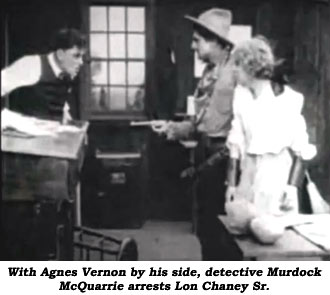  BY THE SUN’S RAYS (1914 Universal) 12 minutes BY THE SUN’S RAYS (1914 Universal) 12 minutes
Dated but historically interesting one-reeler has detective Murdock McQuarrie sent to investigate some mine payroll robberies. Turns out to be an inside job by mine employee Lon Chaney Sr. in one of his earliest film roles. Chaney (1883-1930) came to Hollywood in 1912. He also worked with McQuarrie in “The Tragedy of Whispering Creek” and “Ranch Romance” (both in ‘14). McQuarrie (1878-1942) came from stage work to films in 1902. Appearing in dozens of early one and two-reelers, by the mid-teens he was a leading man at Universal. In the ‘20s he turned to character roles until his death. The leading lady in this short is Agnes Vernon who also made westerns with Franklyn Farnum, William Desmond, Tom Mix and Australia’s Snowy Baker.
Posted 10/11/10
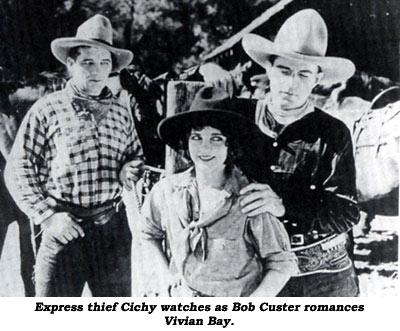  CODE OF THE WEST (1929 Syndicate) 53 minutes CODE OF THE WEST (1929 Syndicate) 53 minutes
Railroad express agent Bob Custer investigates the theft of valuable insured packages from station agent Bobby Dunn’s office. The trail leads Custer to Martin Cichy and his cohorts (Bud Osborne, Cliff Lyons) who are collecting insurance on their own stolen packages. At the same time, Custer must stave off honky tonk owner Tom Bay’s romantic advances toward Dunn’s daughter Vivian Bay (Tom Bay’s real-life wife? sister? She worked in four films with Tom). Directed by J. P. McGowan in a stagnant and disjointed style (except for a slam-bang barroom brawl between Custer and Bay), “Code of the West” plays almost like two separate stories. Also with Buck Bucko as the sheriff and Merrill McCormick as one of Bay’s men. For the record, Bobby Dunn, born August 28, 1890, in Milwaukee, WI, was educated at St. Johns Military Academy. Before entering films he was the champion high diver of the world with Dr. Carver’s diving horses. Entering films in 1912 he became one of the top slapstick and pratfall comedians of the era and was considered (along with Billy West) Charlie Chaplin’s best imitator. Dunn turned to westerns and other supporting roles toward the end of the ‘20s. His early death, at 46, came on March 24, 1937, in Hollywood having just completed a bit in Laurel and Hardy’s “Way Out West”.
  FANGS OF FATE (1925 Chesterfield) 47 minutes FANGS OF FATE (1925 Chesterfield) 47 minutes
Dorothy Donald loves town ne’er-do-well Bill Patton not realizing he is the secret head of a gang of outlaws including Merrill McCormick and Carl Silvera who do not cotton to Patton’s non-violent ways of outlawry. When McCormick disobeys Patton and leads the gang on a murderous raid, Bill sees the error of this ways and accepts a deputy sheriff’s badge, rounds up the gang, then turns himself in to overweight, blowhard sheriff Ivor McFadden. Fortunately, Judge William Bertram, realizing Bill has gone straight, suspends his prison sentence, reuniting Bill with Dorothy. Born in Denver February 5, 1892, lean, angular, unshaven Merrill McCormick had a brief fling on the stage before taking to holding up the stage as a western heavy from 1916 to 1953, a monumental 37 years with over 300 productions, 98% of them westerns. He died of a heart attack in San Gabriel, CA, August 9, 1953, after completing a role in a Gene Autry TVer.
   BLACK CYCLONE (1925 Pathé) 59 minutes BLACK CYCLONE (1925 Pathé) 59 minutes
This is the second film to place Rex the horse in a starring role, the first was “King of Wild Horses” the previous year. Rex, as a newborn colt, is left alone when his mother is killed by a sidewinder. Rejected by a wild herd headed up by a killer Pinto, Rex grows to maturity running free and finds a mate in Lady, only to have her stolen by the Pinto. Meanwhile, in a parallel plot, Big Boy Williams is driven away from his love, Kathleen Collins, by a jealous ex-suitor (Christian Frank). Laying low in the desert, Williams rescues Rex from a bed of quicksand. Figuring this helpful man can also rescue Lady, Rex attempts to lead Big Boy to the Pinto, but Big doesn’t understand the horse’s intentions. Eventually, Lady steals away from the Pinto but returning to Rex is pursued by a vicious wolf pack. Rex, sensing her danger, arrives to drive away the snarling pack. Again, the parallel lives of man and horse connect as Collins is chased into the desert by Frank only to be rescued by Williams just as the Pinto once again attempts to steal Lady but is defeated by Rex. Both man and horse win their mates.

Posted 9/17/10
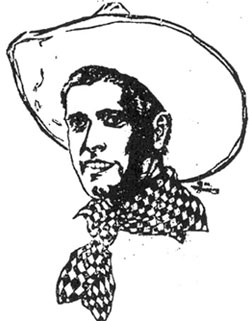   BACKFIRE (1922 Sunset/Aywon) 40 minutes BACKFIRE (1922 Sunset/Aywon) 40 minutes
Jack Hoxie (as Lightning Carson—a name Tim McCoy later used in talkies) and his friend George Sowards are accused of robbing the local Wells Fargo office, a crime actually committed by William Lester and Bert Rollins. Sowards is arrested but Jack escapes, pursued by Sheriff Lew Meehan. (At this point reel two is missing from the surviving print, but apparently Hoxie goes to Sowards’ home where he falls in love with Sowards’ sister, Florence Gilbert, and discovers ranch foreman William Gould is actually the leader of an outlaw gang to which Lester and Rollins belong.) Gould and his gang, holding Gilbert and Sowards’ father for ransom, are exposed by Hoxie who reveals himself to be an undercover Ranger. Exposing Lester and Rollins as the real robbers, he save Sowards from hanging and wins the hand of Gilbert.
  LAW AND THE OUTLAW, THE (1913 Selig Polyscope) 42 minutes LAW AND THE OUTLAW, THE (1913 Selig Polyscope) 42 minutes
Originally a two reeler, Tom Mix’s “The Law and the Outlaw” was combined with scenes from another two reeler to form this version reissued by Exclusive Features in 1920. Produced and directed by William Duncan, Tom is hunted for a crime his younger brother committed. Working at a ranch for tough foreman Lester Cuneo, Tom falls for the bosses’ daughter Myrtle Stedman. When the law catches up with Tom he escapes, is recaptured and escapes again. On the run, Tom’s brother is finally caught and Tom exonerated as he and Myrtle clutch in the fade-out.
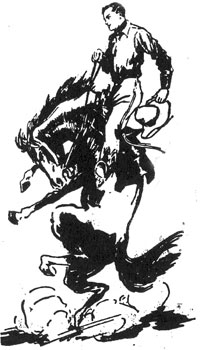    KING OF WILD HORSES, THE (1924 Pathé) 50 minutes KING OF WILD HORSES, THE (1924 Pathé) 50 minutes
If you like horse pictures, this one’s for you. Produced by Hal Roach with the famous horse Rex as the leader of a wild horse herd. Cowboy Leon Barry admires Rex and attempts to capture him, at first to no avail. Eventually, during a raging forest fire, Rex learns to trust Barry as the cowboy leads the horse to safety. Meantime, crooked ranch foreman Pat Hartigan forces the ranch owner’s son, Charles Parrott (aka Charlie Chase) to help him rustle his father’s cattle in order to pay off gambling debts owed Hartigan. Barry and Rex foil Hartigan’s scheme as Barry wins the heart of the rancher’s daughter, Edna Murphy. Thrilling and expert photography under Fred Jackman’s direction. Foaled in Texas in 1915, Rex was registered as Casey Jones. Reportedly abused as a colt, he was eventually sold as a breeding stallion to a Colorado detention home. In 1923, Hal Roach, seeking a black stallion for the lead in this film, assigned Chick Morrison, who looked after Roach’s polo ponies, to find a suitable “star horse”.   Hearing about the “Killer stallion” at the home near Golden, CO, Morrison and gifted horse trainer Jack Lindell went to see Rex. Impressed with the Morgan Stallion, they purchased Rex for $150 and brought him to Hollywood where he was stabled at Clarence “Fat” Jones’ barn. Rex, making his debut in “King of Wild Horses”, went on to star for Roach in “Black Cyclone” (‘25) w/Big Boy Williams and “Devil Horse” (‘26) w/Yakima Canutt. In 1927 Rex was sold to Universal where he appeared in several silents with Jack Perrin. Fat Jones was quoted as saying, “Rex never got to where you could trust him. He was mean to the end.” Mascot later used Rex in several serials including “Law of the Wild” (‘34) and “Adventures of Rex and Rinty” (‘35). Rex also starred as “Smoky” at Fox in ‘33 w/Victor Jory. Rex was eventually retired to Lee Doyle’s ranch in Flagstaff, AZ, where he died in the early ‘40s. Hearing about the “Killer stallion” at the home near Golden, CO, Morrison and gifted horse trainer Jack Lindell went to see Rex. Impressed with the Morgan Stallion, they purchased Rex for $150 and brought him to Hollywood where he was stabled at Clarence “Fat” Jones’ barn. Rex, making his debut in “King of Wild Horses”, went on to star for Roach in “Black Cyclone” (‘25) w/Big Boy Williams and “Devil Horse” (‘26) w/Yakima Canutt. In 1927 Rex was sold to Universal where he appeared in several silents with Jack Perrin. Fat Jones was quoted as saying, “Rex never got to where you could trust him. He was mean to the end.” Mascot later used Rex in several serials including “Law of the Wild” (‘34) and “Adventures of Rex and Rinty” (‘35). Rex also starred as “Smoky” at Fox in ‘33 w/Victor Jory. Rex was eventually retired to Lee Doyle’s ranch in Flagstaff, AZ, where he died in the early ‘40s.
  A MOONSHINE FEUD (1920 Pinellas) 12 minutes A MOONSHINE FEUD (1920 Pinellas) 12 minutes
For the video release of this Texas Guinan one-reeler, the releasing company misidentified and mistitled “A Moonshine Feud” as “White Squaw”. In this fast-paced quickie Texas’ brother is framed as a moonshiner by the moonshiners themselves. It all erupts in a big gun battle and ends with Texas and a “revonooer” in an embrace.
Posted 4/12/10
  DESERT SECRET (1924 Madoc) 55 minutes DESERT SECRET (1924 Madoc) 55 minutes
Bill Patton and his partner strike gold. Riding to town for supplies, Patton befriends Pauline Curley who is having car trouble. In town, lowlife gambler Lew Meehan suspects Patton has found gold and attempts—to no avail—to learn the mine’s location. (At this point watch for the surprise scene where Pauline drives her car through the saloon doors to help a besieged Patton.) Later, while Bill is away, his drunken partner comes to town and spills the beans as to the location of their strike. Believing his claim lost to the hordes of prospectors, a distraught Patton wanders the wasteland until he returns two years later to learn Pauline filed on the claim for him. A thriving community has emerged around the diggings and Bill is a rich man. A bit episodic but also a bit offbeat.
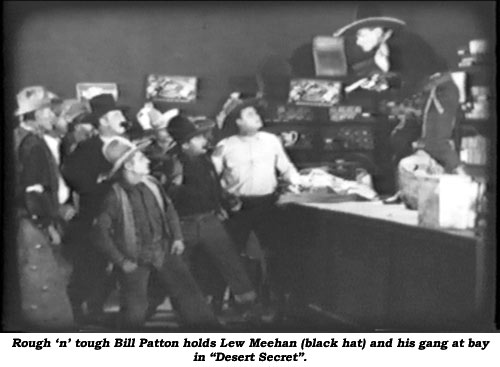
 THE SHERIFF AND THE RUSTLER (1913 Selig) 14 minutes THE SHERIFF AND THE RUSTLER (1913 Selig) 14 minutes
Sheriff Lester Cuneo pursues rustler Tom Mix and catches him. Couple of nice stunts. This two-reeler may have been intriguing in 1913 but today it’s very dated with all medium and long shots and emerges as nothing more than a Mix curio.
  KENO BATES, LIAR (1915 Mutual Kay-Bee) 21 minutes KENO BATES, LIAR (1915 Mutual Kay-Bee) 21 minutes
William S. Hart as gambler Keno Bates is owner of a gambling hall with partner Herschel Mayall. Mexican saloon gal Louise Glaum is infatuated with Keno but he carelessly dismisses her. Feeling cheated (for no reason) by Keno, Gordon Mullen holds up the saloon and escapes. In the pursuing gun battle Keno kills the bandit. He then learns Mullen’s sister, Margaret Thompson, who has no one to turn to, is coming west. Keno lies to Margaret, telling her Mullen was killed in a mining accident. Friendship turns to love but Glaum, in a fit of jealousy, tells Margaret that Keno shot her brother. Enraged, Margaret confronts Hart and shoots him. Heartbroken and wounded, Hart rides off to die. Fortunately, Mayall tells Margaret the true circumstances of her brother’s death as Margaret rushes to save Hart and nurse him back to health.
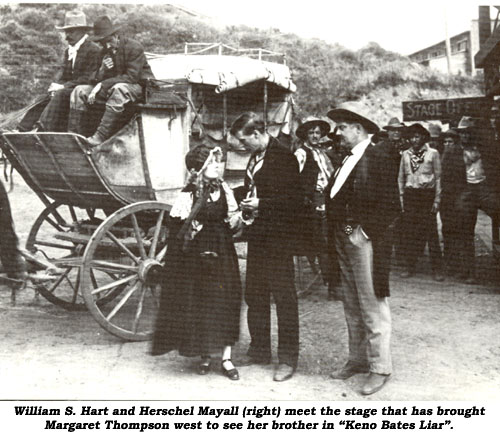
  FIGHTING STRAIN (1923 Steiner) 51 minutes FIGHTING STRAIN (1923 Steiner) 51 minutes
In this odd little melodrama written and directed by star Neal Hart, his sister, Beth Mitchell, is tricked into believing her brother has been killed in action in France during WWI, so she married swindler William Quinn and moves with him from Montana to Canada. Hart and war buddy James McLaughlin return from the war to New York where Hart meets McLaughlin’s rich father, Burt Wilson, and sister, Gladys Gilland. Only in the movies, it so happens Wilson has a mining claim in Canada. Sending his son and daughter to check on affairs there, they find Quinn has cheated them out of their claim. Meanwhile, Hart returns to Montana only to learn he’s believed dead by his sister. He tracks the scoundrel Quinn to Canada where all parties converge just as Quinn and his underlings are planning their get-away. Corralling Quinn, Neal marries Gladys and arranges for his sister to marry his new brother-in-law.
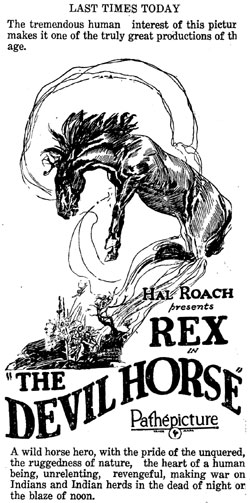     DEVIL HORSE, THE (1926 Pathé) 62 minutes DEVIL HORSE, THE (1926 Pathé) 62 minutes
A higher budget from producer Hal Roach and distribution by Pathé enhanced “Devil Horse” considerably. Throbbing with energy from director Fred Jackman and soon to be ace director George Stevens, the sweep of “Devil Horse” carries it far beyond the standard B. The term “action packed” is not used lightly in this minor classic. Mistreated as a Colt by Indians and separated from his young master, Rex, King of Wild Horses, grows up to become the leader of a wild herd, hating all Indians and killing them at every opportunity, yet holding a faint memory of the boy who befriended him. That grown boy is Yakima Canutt, now an Army scout also with a hatred of the Indians who killed his parents and mistreated his colt. At the Cavalry post is Gladys McConnell, the commanding officer’s daughter, and her horse, Lady. Seeing Lady being ridden by Gladys, Rex is smitten with the beautiful silver horse much the same as Yak has fallen for Gladys. Indian Chief Prowling Wolf (despicable Robert Kortman) has lecherous desires on Gladys, inciting his tribe to the warpath so he can capture the young woman and Lady. When Yak and Rex are finally reunited after Yak is nearly killed by the devil horse, the pair race to the rescue. Yak defeats Prowling Wolf while Rex Battles a killer Indian horse. Giving the film an authentic look, hundreds of Indians of the Crow tribe were employed. In his autobiography, STUNT MAN, Yak recalled “Devil Horse” in detail.
“I thought that my time had come, when, in 1926, I was loaned to Hal Roach to play the leading role in “The Devil Horse”(not to be confused with the Nat Levine serial of 1932). Hal Roach was the producer, Fred Jackman the director, his brother, Floyd Jackman, was head cameraman, and George Stevens, who was later to become a famous director, was the second cameraman. This picture was the biggest and best of the films in which I played the leading role.
We set up a complete camp on the shores of the Little Big Horn River, not far from the Custer Battlefield. We built a log fort for the Indian battle scene and at times used as many as four or five hundred Indians. The plot called for a lot of action, and I did it all. I played a pioneer whose wagon train had been wiped out when he crossed the wilderness as a child. There was a moving scene where the child is captured by the Indians as he is playing with his pet colt.
I played the child grown to manhood. In the picture, I’m having a running fight with four or five Indians. They over-power me and sentence me to be tied to a tree at the mercy of the Devil Horse. As you might have guessed, the killer stallion turns out to be my former pet colt. He recognizes me, unties my ropes with his teeth, and we ride off, to the Indians’ amazement.
I had pretty good luck working with horses, but when you find out that a horse is actually a killer stallion, you know that you have to be on your guard. Rex, the “Devil Horse” of the picture was a big, beautiful well-trained black, but every so often he would get mad and try to kill anyone near him. After he killed his keeper he was sold to Hal Roach. In his first film, “Black Cyclone”, Rex knocked down the leading man, Big Boy Williams, and really ripped him up. If the trainer hadn’t run in and settled Rex down, Big Boy would certainly have been killed.
Although the tree scene went fine, things didn’t run so smooth later on when I was doing a scene where Rex was to run to me during an Indian battle. He had made the run three or four times, but the director didn’t like any of them. After a couple of more runs, I warned the director that the horse was getting mad and we better let him cool off. He said, “Let’s try one more take.” After that “one more” it was time to call an ambulance.
The old horse charged and, when he got within about ten or twelve feet from me, he laid his ears back, opened his mouth and came at me with everything he had. I tried to duck, but his upper teeth hit my left jaw and his lower teeth got my neck. I was knocked to the ground and he reared above me, striking down with his powerful front hooves. I rolled away frantically and, when he rushed at me to bite, I kicked him on the nose and rolled away again. The trainer ran in with a buggy whip, but the horse kept right after me. I finally rolled over a bank and escaped.
Some of my other stunts in this picture were just as hazardous, but the finished effect was quite striking. I worked closely with George Stevens and he knew his trade. He’d use wide angles to make falls look higher and slow camera speeds to make movements appear faster. After finishing that picture I worked with Stevens on several of the Ben Wilson Westerns and learned a good deal from him. One day George said to me, “Yak, I’d like to direct a couple of pictures for you.” “You’re a good cameraman, George,” I replied. “Why don’t you stay with what you know. I don’t think you’d make it as a director. “
Fortunately for the thousands who’ve enjoyed “Gunga Din”, “Shane”, “Giant” and many others, he didn’t take my advice. In a few years he was among the top directors in Hollywood.”
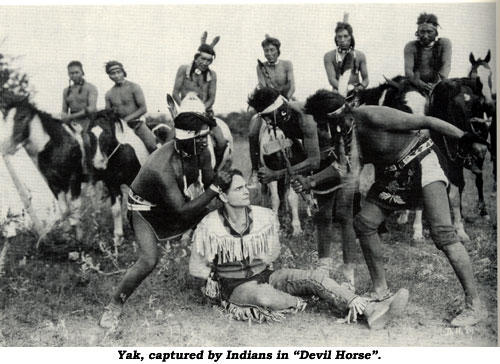
 TRACY THE OUTLAW (1927 Foto-Art) TRACY THE OUTLAW (1927 Foto-Art)
Texas made western with no-name actors purportedly based on the real life exploits of Harry Tracy (1874-1902). Problem is, the film takes vast liberties with Tracy’s outlaw career, calling him “more a victim of the sins of others than his own,” when, in fact, Tracy was one of the worst, mean-minded killers to come out of Butch Cassidy’s old Wild Bunch. Tracy’s outlaw career was also fictionalized on TV’s “Stories of the Century” with Steve Brodie and in “Harry Tracy—Desperado” with Bruce Dern in ‘82.
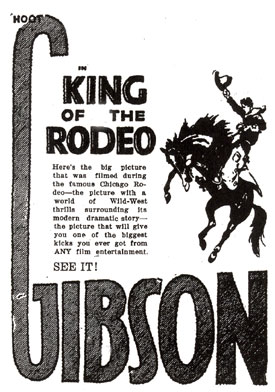  KING OF THE RODEO (1929 Universal) 62 minutes KING OF THE RODEO (1929 Universal) 62 minutes
Droll comic western with Hoot Gibson as a Montana cowboy come to Chicago to enter the big rodeo at Soldier Field. He quickly meets and falls for Kathryn Crawford, the daughter of an official with the rodeo. The midsection of the film is saddled with a passel of rodeo footage before a final—and finally—exciting 15 minutes as Hoot pursues a thief who robbed the rodeo cashier’s office and, Hoot believes, stole his shirt (!) Hoot chases the crook through Chicago traffic in a taxicab and by motorcycle before he snares his prey.
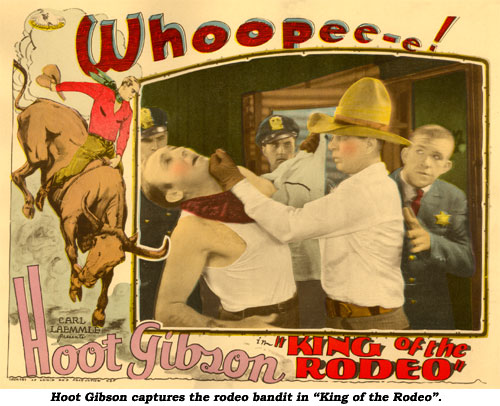
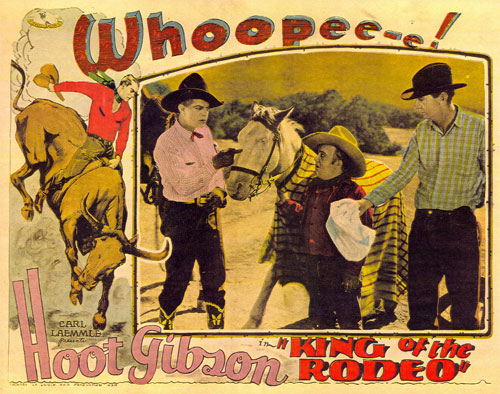
 A DESERT WOOING (1918 Paramount) A DESERT WOOING (1918 Paramount)
In this slow-moving society drama cum western, top-billed Enid Bennett is the soft, silk-sheathed, carefully-nurtured, spoiled Eastern girl whose desire for a rich husband outweighs her desire for true love. Meanwhile, she dallies with no-good idler Donald MacDonald. Wealthy, virile Arizona cattleman Jack Holt visits back east on business, meets the pretty husband-seeker, marries her and takes her west. MacDonald follows and one night Jack discovers the cad in his wife’s room. After soundly thrashing MacDonald, Jack learns exactly why Enid married him. To teach her how to be a “true wife” he spirits her off to the desert where she at last realizes what a wonderful man she has in Jack, eventually saving Holt from MacDonald’s vengeful wrath. More romance than true western, obviously aimed at the female trade in 1918.
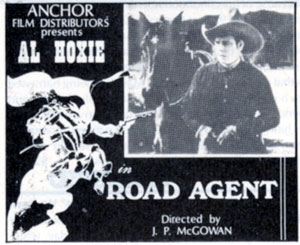   ROAD AGENT (1926 Anchor/Rayart) 47 minutes ROAD AGENT (1926 Anchor/Rayart) 47 minutes
Producer Morris Schlank signed Al Hoxie in 1926 for a series of eight westerns. Al had been knocking around the film business in small roles for some six years so he knew his way around a camera but Schlank figured to trade on the Hoxie name and the fact Al looked a great deal like brother Jack who, by then, was a formidable silent star. Bob Reeves was also doing a series for Schlank at the same time as Al. Both actors were sent with pretty much a common cast and crew to Arkansas for location shooting. Al shot for a week while Reeves sat around, then Reeves and cast filmed while Al relaxed, then they all returned to Hollywood for the interiors. In “Road Agent”, directed somewhat sloppily by J. P. McGowan, as all Al’s Schlank produced westerns were, Hoxie plays a dual role as The Kansas Kid and Roger Worth. Scheming lawyer Lew Meehan tells his henchman, Leon de la Mothe, if sickly Mrs. Worth’s (Florence
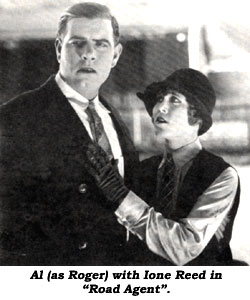 Lee) son, Roger, doesn’t show up by week’s end the estate will pass to niece Ione Reed who is caring for Mrs. Worth. Then, in a bar, Meehan spots the wanted fugitive The Kansas Kid who happens to be a dead ringer for Roger. Meehan convinces Al to impersonate Roger and take possession of the ranch for him. Mrs. Worth accepts Al as her long lost son but upon meeting “Mother” and “cousin” Ione he Lee) son, Roger, doesn’t show up by week’s end the estate will pass to niece Ione Reed who is caring for Mrs. Worth. Then, in a bar, Meehan spots the wanted fugitive The Kansas Kid who happens to be a dead ringer for Roger. Meehan convinces Al to impersonate Roger and take possession of the ranch for him. Mrs. Worth accepts Al as her long lost son but upon meeting “Mother” and “cousin” Ione he
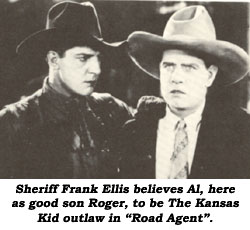 softens under the new environment and calls off the deal with Meehan. Things get confusing when the real son arrives, but Al fesses up, sending Meehan and La Mothe off to jail with Sheriff Frank Ellis. Mrs. Worth is reunited with her real son, never realizing the former deception, and Ione vows to wait for Al until he is released from his prison sentence. softens under the new environment and calls off the deal with Meehan. Things get confusing when the real son arrives, but Al fesses up, sending Meehan and La Mothe off to jail with Sheriff Frank Ellis. Mrs. Worth is reunited with her real son, never realizing the former deception, and Ione vows to wait for Al until he is released from his prison sentence.
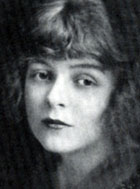  THAT GIRL MONTANA (1921 Pathé) 67 minutes THAT GIRL MONTANA (1921 Pathé) 67 minutes
Blanche Sweet (1896-1986) was one of the big names of the silent screen. She began her career at 13 with D. W. Griffith and later worked for many top directors. “That Girl Montana”, based on a popular 1901 novel, one of Sweet’s later films, finds her as the daughter of no-account gambler and thief, Edward Peil. When Peil is chased out of town, and reportedly killed by revenge-seeking prospector Frank Lanning whom Peil earlier robbed and left to die, Sweet at first lives on an Indian reservation until she meets prospector Mahlon Hamilton and becomes his ward. Gaining femininity; she’d dressed as a tomboy for years, she eventually falls in love with Hamilton. After a wild series of western soap-opera situations, including the reappearance of Hamilton’s saloon girl wife (!) as well as the believed dead Peil, it’s learned Sweet is truly the long-lost daughter of Lanning and a partner in his rich gold mine.
  DEMON RIDER (1925 Davis) 51 minutes DEMON RIDER (1925 Davis) 51 minutes
Rodeo star Ken Maynard came to Hollywood in 1923. After a few brief supporting roles at Fox, he learned his option was not being picked up. He rode as Paul Revere in Cosmopolitan’s “Janice Meredith” in ‘24 and from that was hired by low budget independent Davis Films to make a series of eight westerns. Financial troubles plagued Davis and only five were completed, of which “Demon Rider” seems to be the second. For this series Ken purchased a golden palomino for $750. Ken’s friend Edgar Rice Burroughs suggested the horse be named Tarzan. The first few minutes of this rare print are missing but obviously ranch foreman Maynard captures an outlaw gang led by Tom London but during a mix-up Sheriff Fred Burns suspects Ken of being the gang’s secret boss as Ken has the money which he intends to return. However, he drops it during a struggle with pursuing deputies and a black cook (James Low) picks it up as Maynard is pursued by both the Sheriff and the gang. The outlaws commandeer a touring car from a group of lady tourists as they give chase to Ken. At the finale, roping London from the car as it careens over a cliff, Ken manages to secure a confession from the outlaw as Low shows up to return the stolen money to the Sheriff.
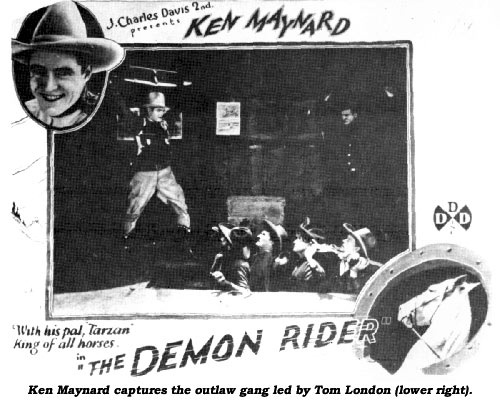
 THE BIG DIAMOND ROBBERY (1929 FBO) 22 minutes THE BIG DIAMOND ROBBERY (1929 FBO) 22 minutes
When Tom Mix’s Fox contract came to an end in mid 1928, he signed for a vaudeville tour, setting a house record at the Hippodrome in New York and was a big hit at the State-Lake in Chicago. Clear that Tom was still potent box office, FBO (Film Booking Offices of America) signed Mix to replace their big attraction, Fred Thomson, who had left FBO for Paramount. Hoping to duplicate Thomson’s huge success, FBO signed Tom Tyler, Bob Custer, Bob Steele and Buzz Barton—but none managed the stellar drawing power of Thomson. So, when Mix became available, FBO signed him to make six silent westerns. Unfortunately, FBO’s production values didn’t quite match his Fox output. That, combined with the impending end of silent pictures, curtailed Tom’s FBO career and he only completed five of the planned six. Of the five, only a portion of his last, “The Big Diamond Robbery”, survives, and it’s the middle section found by a collector in Germany in a well-worn 9.5mm gauge library print. But the opportunity to at least see some of Tom’s FBO work compensates for the losses. Apparently, the early part of the film constitutes a western comedy-drama. In the surviving mid-section, ranch foreman Tom arrives in an eastern city to meet with ranch owner Frank Beal. Beal’s society playgirl daughter Kathryn McGuire has been arrested, again, for speeding. To keep his daughter out of trouble, Beal plans to send her west under Tom’s supervision. Tom is to also guard a precious diamond, a gift for McGuire. But, before Tom can take possession of the jewel, the gem is stolen by Ernest Hilliard’s gang. Tom spots them, trails them to their den where he overpowers the henchie guarding the diamond and uses the man’s chewing gum to secret the jewel beneath a table before he is captured by Hilliard’s gangsters. Tom breaks loose with the diamond and the gang chases him in a hair raising rooftop sequence. Unfortunately, this is basically where the surviving footage ends. Apparently, the gang followed Mix and McGuire west where they once again attempt to gain possession of the gem. What survives is interesting and fun. One wishes the rest of Mix’s FBO output were not lost to the ravages of time.
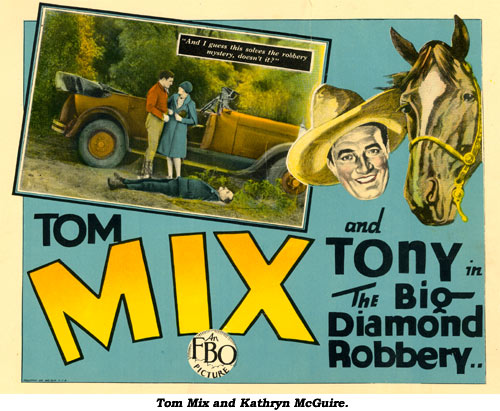
Posted 3/6/10
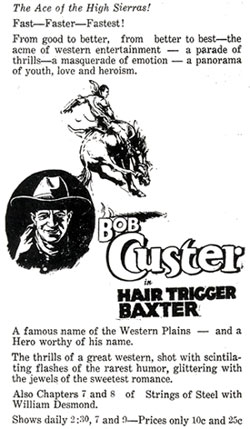   HAIR TRIGGER BAXTER (1926 FBO) 30 minutes HAIR TRIGGER BAXTER (1926 FBO) 30 minutes
Raymond Anthony Glenn, born Oct. 18, 1898, in Frankfort, KY, had visions of becoming an actor. After graduation from the University of Kentucky with a civil engineer degree, Glenn headed for California. After working as an extra and in bit parts for a couple of years he learned producer Jesse Goldburg was looking for a new western star, with the name Bob Custer already selected. Goldburg offered Glenn a contract with the first film “Trigger Fingers” released through FBO in late 1924. In all, between ‘24 and ‘27, Bob turned out 24 action packed westerns under Joseph P. Kennedy’s FBO banner. Unfortunately, these well produced films are lost to the ravages of time, but we are at least
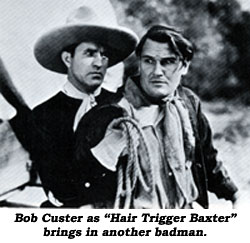 fortunate to have many of them in condensed form as narrated juvenile episodes of “Billy’s Bang Bang Western Theatre” (edited and released to early TV by MGM). In the action packed “Hair Trigger Baxter” Broncho Bob is an undercover detective for the cattleman’s Association who not only brings to justice rustlers Lew Meehan and Jim Corey but rescues leading lady Eugenia Gilbert from Meehan’s dance-hall clutches after being consigned there by her loathsome uncle, Murdock McQuarrie, and saves Gilbert’s brother Ernie Adams from lynching after getting mixed up with crooked gamblers.
fortunate to have many of them in condensed form as narrated juvenile episodes of “Billy’s Bang Bang Western Theatre” (edited and released to early TV by MGM). In the action packed “Hair Trigger Baxter” Broncho Bob is an undercover detective for the cattleman’s Association who not only brings to justice rustlers Lew Meehan and Jim Corey but rescues leading lady Eugenia Gilbert from Meehan’s dance-hall clutches after being consigned there by her loathsome uncle, Murdock McQuarrie, and saves Gilbert’s brother Ernie Adams from lynching after getting mixed up with crooked gamblers.
 SAGEBRUSH TOM (1915 Selig) 12 minutes SAGEBRUSH TOM (1915 Selig) 12 minutes
Tom Mix comedy western. Tom writes a fan letter to movie actress Myrtle Stedman. When the Selig Polyscope Company comes west to make a movie, Tom meets the girl of his affections only to learn she’s married with a child. The saving grace of these silly Selig one-reelers is the boyish charm of Mix.
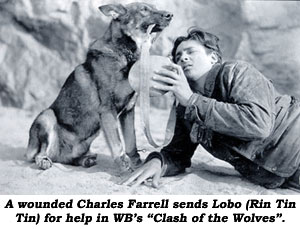    CLASH OF THE WOLVES (1925 Warner Bros.) 57 minutes CLASH OF THE WOLVES (1925 Warner Bros.) 57 minutes
Rin Tin Tin is Lobo, a half breed wolf who leads his pack when they are driven into the desert by a forest fire. To survive, the pack attacks rancher’s cattle. When Lobo is injured by a fall into some cactus he is rescued, befriended and tamed by Borax prospector Charles Farrell. When Farrell makes a strike, vicious claim jumper Pat Haritgan shoots him and leaves him for dead during a wild sandstorm. However, Farrell, still alive, sends Lobo with a message to his girl, June Marlowe. Learning of this, Hartigan returns to the scene of the crime to finish off Farrell but Lobo intervenes. Summoning his pack, they chase down and finish off the vile Hartigan. Top Warner Bros. production packed with exciting thrills. Silent comedian Heine Conklin provides a few chuckles as a teamster.
 DANCIN’ DUDES (1926 Universal) 10 minutes DANCIN’ DUDES (1926 Universal) 10 minutes
In this western comedy Pee Wee Holmes and Ben Corbett get involved at a dance with a phony bear (Bob McKenzie) and a real bear.
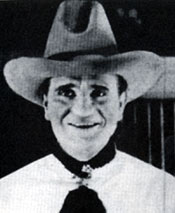   TWO DOYLES (1919 Canyon Pictures) 20 minutes TWO DOYLES (1919 Canyon Pictures) 20 minutes
Donald Doyle (Franklyn Farnum) and his wife (Mary Bruce) plan to homestead near Canyon City with no idea Don’s rapscallion of a twin brother Jerry (also played by Farnum) is in the vicinity. Jerry “holds up” the stage—sort of—all he takes is a kiss from lovely passenger Lola Maxam. Fleeing, he stops for a meal with the Bar-X outfit until he realizes it is a gang of rustlers led by crooked sheriff Vester Pegg and his right hand man Buck Jones. Happening upon brother Donald beset by Indians, Jerry helps fight them off. Donald’s wife is killed and Jerry believes Donald also dead so he takes their child to raise. But Donald is not dead, but when he realizes Jerry is the stage
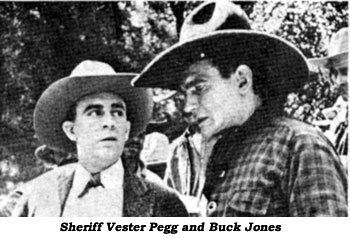 bandit sought by the law, Don resolves to protect the brother who had not hesitated to protect him in the skirmish with the Indians. Fortunately, Lola discovers the mixup and informs Jerry who turns himself in to set Don free. Jerry too is released when Lola reveals all Jerry stole was a kiss. Then, spotting the crooked sheriff, Jerry outs Pegg as the wanted rustler leader. (Watch quickly toward the end for a young Bud Osborne as a member of the citizen’s committee.) bandit sought by the law, Don resolves to protect the brother who had not hesitated to protect him in the skirmish with the Indians. Fortunately, Lola discovers the mixup and informs Jerry who turns himself in to set Don free. Jerry too is released when Lola reveals all Jerry stole was a kiss. Then, spotting the crooked sheriff, Jerry outs Pegg as the wanted rustler leader. (Watch quickly toward the end for a young Bud Osborne as a member of the citizen’s committee.)
Posted 2/18/10
top of page
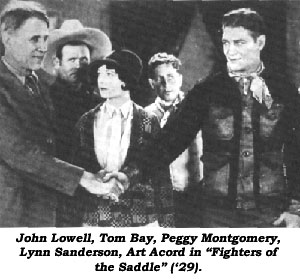  FIGHTERS OF THE SADDLE (1929 Davis) 48 minutes FIGHTERS OF THE SADDLE (1929 Davis) 48 minutes
In the rather lethargic “Fighters of the Saddle” Art Acord’s father John Lowell is buying up land on speculation of a right of way for a valuable county road. Art opposes his father’s tactics in driving out the settlers to gain their land. Making matters worse is Art’s cousin Tom Bay (and his henchman Cliff Lyons) who stirs up even more trouble between Art and his Dad. It all comes to a head when Lowell tries to gain control of the ranch owned by Art’s love interest, Peggy Montgomery, and her brother Tom Ponder. Lowell eventually realizes his greed is costing him the respect of his son.
Art Acord has been described as a “Cowboy’s Cowboy”. Entering films circa 1909 he began starring in westerns in 1915, reaching his zenith in 1920-‘21 with “The Moon Riders” and “White Horseman” Universal serials. But after several bouts with booze, Universal, finally fed up with the carefree, troublemaking cowboy, did not pick up his option for 1928. Independent Davis Productions used the nearly down-and-out Acord for a series of six low budget westerns in ‘29, nowhere near up to the standard of his earlier Universals. Things went from bad to worse—Art was injured in a gas heater explosion at his home in ‘29, then was arrested for bootlegging and robbery. Somehow extricating himself from the charges, he traveled to Mexico on personal appearances where, at 40, he died January 4, 1931, under mysterious circumstances in a Chihuahua, Mexico, hotel. Some reports say he died of a knife wound, others say cyanide poisoning by his own hand, yet others report simple alcohol poisoning.
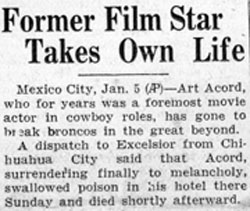
Mexican law required the burial of corpses within 24 hours after death. After a week of misunderstandings and mistrust there occured the following bizarre event...
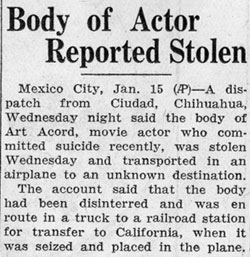
By the time Art's body arrived in El Paso, Texas it had been embalmed in Mexico but additional measures were taken in El Paso before a funeral was held...
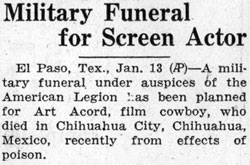
Eventually Art's body was entrained to L.A. by the American Legion and VFW. Art was buried January 17, 1931 at Forest Lawn Memorial Park in Glendale, CA.
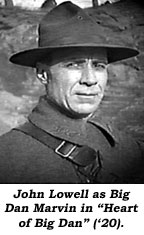   HEART OF BIG DAN (1920 Arrow) 25 minutes HEART OF BIG DAN (1920 Arrow) 25 minutes
John Lowell (1875-1937) starred in 12 Big Dan Marvin Northwest Mountie shorts in 1920, all produced by Blazed Trail Productions, filmed in the Adirondack mountains of New York and distributed by Arrow. Most, if not all, of them were scripted by Lowell’s wife Lillian Case Russell (1876-1947), a prolific writer who began her career some five years before John entered films. Their daughter Evangeline Russell, born in 1902, worked in pictures from 1923 to 1929, almost always portraying an Indian maiden, as she did in Lowell’s “Red Love” (‘25). Dakota Lawrence co-starred with Lowell in “Heart of Big Dan” and the other Big Dan Marvin films. In this episode, Lowell thwarts mine owner and opium smuggler Charles Robbins and plays cupid to Dakota Lawrence and Robert Hamilton who unthinkingly at first works for Robbins.
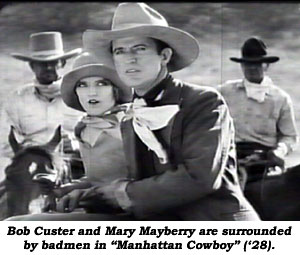    MANHATTAN COWBOY (1928 Syndicate) 54 minutes MANHATTAN COWBOY (1928 Syndicate) 54 minutes
Bob Custer shows why he was a force to be reckoned with in silent westerns. The yarn is nothing new but it’s well handled by director J. P. McGowan and a great cast. In the big city Custer’s father, Lafe McKee, gives his playboy son one more chance to “either go to work or get out.” So off Bob goes to work on the friend of his father’s ranch (John Lowell) where Bob quickly falls for Lowell’s daughter Mary Mayberry. After a time Custer’s Mom sends him a priceless family heirloom, a valuable necklace, for Bob to give to his betrothed Mary. Trouble arises when three raunchy ranch hands (Charles “Slim” Whitaker, Cliff Lyons, Mack V. Wright) kidnap Mary and the necklace. Fast paced and thoroughly enjoyable with some terrific riding sequences from Cliff Lyons (1901-1974) who became one of the best all-around stuntmen and second unit directors in the business. Mack V. Wright (1894-1965) became one of the top assistant directors and directors in the B-western sound era. With over 350 film credits, Slim Whitaker was one of the preeminent heavies in westerns from 1914-1948. (For more on John Lowell see “Heart of Big Dan”).
Posted 12/06/09
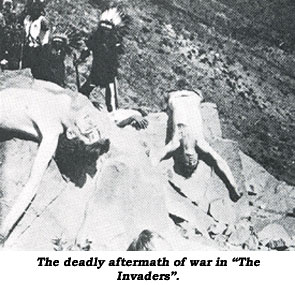   THE INVADERS (1912 Mutual/Kay-Bee) 35 minutes THE INVADERS (1912 Mutual/Kay-Bee) 35 minutes
Even though there is a treaty with the Sioux, the government permits railroad surveyors to cross onto Indian land. The Indians protest, to no avail, leading to an uprising. Although totally wronged, the Indians are defeated. Remarkably well done production for its time, overseen by Thomas H. Ince. Although Ince and Francis Ford are listed as co-directors, one suspects it is all the work of Ford (brother to John Ford) who also portrays the Colonel in the film. Many of the Ince helmed films, produced by tough businessmen Adam Kessel and Charlie Bauman under their 101-Bison banner were released through Carl Laemmle’s Motion Picture Sales and Distributing Company. “The Invaders”, as produced by Kessel and Bauman, was slated to be released by Carl Laemmle’s newly formed Universal, but due to continuous and convoluted business dealings was switched at the last minute to Mutual. Laemmle sued so Kessel and Bauman quickly devised their Kay-Bee brand. Watch for silent-star-to-be Art Acord as a telegraph operator in a brief sequence.
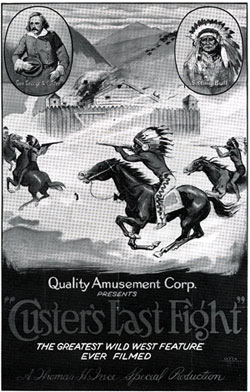     CUSTER’S LAST FIGHT (1912 Bison) (1925 Reissue) 44 minutes CUSTER’S LAST FIGHT (1912 Bison) (1925 Reissue) 44 minutes
Released in the same year as “The Invaders” and once again purportedly co-directed by Thomas H. Ince and Francis Ford, “Custer’s Last Fight” provides a very accurate step-by-step retelling of the events leading up to Colonel Custer’s massacre at the Little Big Horn. Here again Francis Ford plays the doomed Colonel and Art Acord plays a small part as one of the Cavalry men, but the final production looks even better and moves better than “The Invaders”.
   THE BATTLE OF ELDERBUSH GULCH (1914 Biograph) 23 minutes THE BATTLE OF ELDERBUSH GULCH (1914 Biograph) 23 minutes
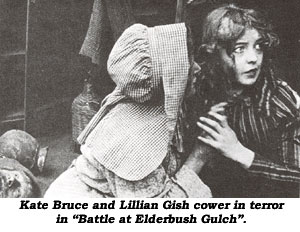 Two young girls, Mae Marsh (and her baby) and Lillian Gish, are sent to live on the frontier with their cantankerous uncle. The Indians attack but the settlers are saved at
Two young girls, Mae Marsh (and her baby) and Lillian Gish, are sent to live on the frontier with their cantankerous uncle. The Indians attack but the settlers are saved at
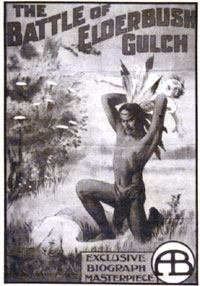 the last minute by the Cavalry in a scene that became a western staple over the years. In this simple early western, director D. W. Griffith shows us why be became such a famed moviemaker. Within 23 minutes he instills rich details, excellent pacing and provides suspenseful, exciting battle sequences. Griffith uses the camera particularly well, shooting wide unsettled expanses of the then barely populated San Fernando Valley where Griffith built a town set just for this two-reeler. the last minute by the Cavalry in a scene that became a western staple over the years. In this simple early western, director D. W. Griffith shows us why be became such a famed moviemaker. Within 23 minutes he instills rich details, excellent pacing and provides suspenseful, exciting battle sequences. Griffith uses the camera particularly well, shooting wide unsettled expanses of the then barely populated San Fernando Valley where Griffith built a town set just for this two-reeler.
  WITH SITTING BULL AT THE SPIRIT LAKE MASSACRE (1927 Sunset) 54 minutes WITH SITTING BULL AT THE SPIRIT LAKE MASSACRE (1927 Sunset) 54 minutes
Produced by Anthony J. Xydias and directed by Robert North Bradbury, this is a hysterical-historical lowbudget action affair about Sitting Bull. (With the emphasis on the Bull!) Renegade brothers Jay Morley and Leon Kent along with Anne Schaefer, known to the Indians as a white witch but nevertheless listened to by the Indians for her “prophecies”, are rejected by the wholesome Spirit Lake, Iowa, settlement. Trading fire water to Sitting Bull (Chief Yowlachie), Schaefer tells the Indians they will be victorious in battle. Meanwhile, a romantic subplot evolves between heroic Bryant Washburn, his kid brother Robert Bradbury Jr. (later Bob Steele) and Spirit Lake sisters Shirley Palmer and Lucille Ballard. The Indians raid Spirit Lake but Washburn and Steele save the girls. Feeling betrayed, Sitting Bull wreaks the ‘Vengeance of the Squaws’ on Schaefer and the unholy brothers.
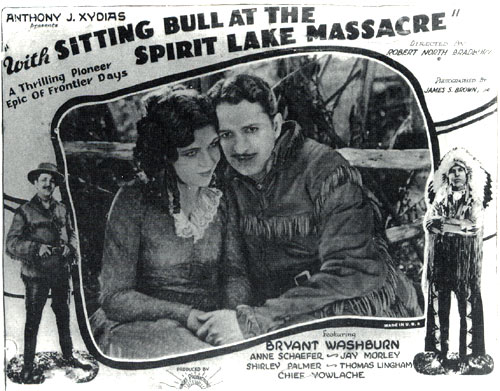
  CYCLONE JONES (1923 Aywon) 50 minutes CYCLONE JONES (1923 Aywon) 50 minutes
Old timer J. P. (Lafe) McKee arrives out west with his daughter, Kathleen Collins, intending to raise sheep. Guinn “Big Boy” Williams warns him this is cattle country, but elects to partner-up with McKee anyway…obviously with a quick eye for Collins. Big cattleman Fred Burns hires scalawag Bill Patton, who’s had trouble with Williams before and carries a grudge, to run Lafe off his land. Low budgeter leans heavily on the comedic as many of Big Boy’s westerns do.
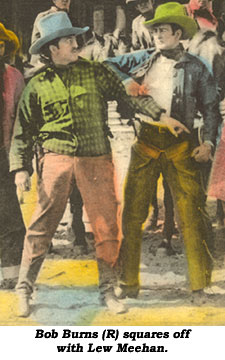   JUST TRAVELIN’ (1927 Sierra) 53 minutes JUST TRAVELIN’ (1927 Sierra) 53 minutes
Bob Burns, his horse Nero, and saddlepal Tex Hewston are “jus’ travelin’” when they come across pretty Dorothy Donald being manhandled by smarmy Lew Meehan (whose laughable hammy screen mugging in this film makes Oilcan Harry look like Lawrence Olivier). Not only does Bob rescue Dorothy, but then drives Meehan away from Dorothy’s father, Harry O’Connor, who has found gold. Directed by Horace Carpenter, “Just Travelin’” is typical, standard silent B-western fare highlighted by a few nice action scenes. Bob, younger brother of well known character player Fred Burns, was born in Montana in 1884. He is not to be confused with comedian Bob (Bazooka) Burns, Robert E. Burns or Bobby Burns. Growing up on a Montana ranch, when old enough Bob joined Buffalo Bill’s Wild West Show as a Roman style trick rider and fancy roper. By 1911 Bob was working extra and as a stuntman…small roles followed. Universal starred Bob in a series of two-reelers in 1919-1920. Following these Bob made 12 two-reelers for Capital release in 1920-‘21. He graduated to feature westerns in 1921 with “Thorobred” and “A Woman’s Wits”. Bob was then awarded a series with lowbudget Sierra Pictures in 1924-1926. From the end of the silent era through 1947 Burns worked in dozens of supporting roles, often as a Sheriff. He died August 20, 1947.
    STAGECOACH DRIVER AND THE GIRL (1915 Selig) 12 minutes STAGECOACH DRIVER AND THE GIRL (1915 Selig) 12 minutes
Possibly the best of Tom Mix’s surviving Selig one-reelers with plenty of fast action as stage driver Tom saves the money shipment from E. J. Brady’s bandits and wins the affections of eastern girl Louella Maxam. There’s a wild scene where one of the stagecoach horses is shot and goes down and another when the whole stage overturns.
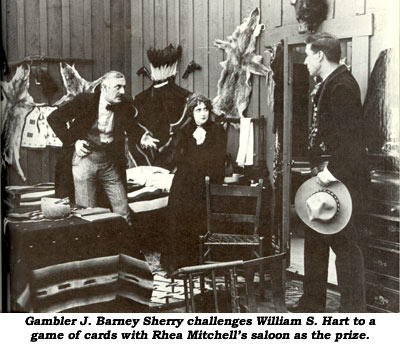  MR. SILENT HASKINS (DEALING FOR DAISY) (1914 Mutual Kay-Bee) 9 minutes MR. SILENT HASKINS (DEALING FOR DAISY) (1914 Mutual Kay-Bee) 9 minutes
Unfortunately, all that exists of this early William S. Hart two-reeler is a one reel Paul Killiam narrated edit, released for TV in ‘53. Eastern girl Rhea Mitchell comes west to claim her inheritance and discovers it’s a gambling and dance hall managed by Hart. Shocked, Mitchell wants to close the joint, but this angers the local cowboys. Professional gambler J. Barney Sherry offers to marry Mitchell and take over the business, but he and Hart have words as Hart offers the same. The men elect to decide the outcome in a card game. (Much of the second reel is not included on this excerpt.)
  ONE WILD TIME (1926 Universal) 24 minutes ONE WILD TIME (1926 Universal) 24 minutes
Yearning to be married, Pee Wee Holmes considers a mail order bride. Before he can mail off his advertisement, his pal Ben Corbett dissuades him with a tale of married woe (a sort of dream sequence with Fay Wray). Pee Wee reconsiders but Ben trickily keeps the ad. When both are smitten by eastern-girl-come-to-town Dorothy Gulliver, Benny sneakily mails off the mail-order-bride ad anyway hoping to get Pee Wee “out of the picture” with Dorothy. The ad is well read and a “thundering herd” of prospective brides arrive by stagecoach, swarming over Pee Wee. The situation is resolved by rounding up all the local eligible bachelors and letting Judge Robert McKenzie perform a mass wedding! Meanwhile, Dorothy runs off and marries the local haberdasher leaving Pee Wee and Ben swearing off women…for about a minute until another cutie rides by. Original title was “One Wild Time” but surviving prints are retitled “Having a Good Time”.
   NOTCH NUMBER ONE (1924 Arrow) 15 minutes NOTCH NUMBER ONE (1924 Arrow) 15 minutes
Only excerpts survive from this silent which bears the dubious distinction of featuring the use of marijuana in its plotline. The devil weed’s use is exaggerated as badly as in the classic “Reefer Madness”. In the surviving footage ranch foreman Ben Wilson comes to the aid of young Reed Howes who has gone wild smoking pot and while in a drugged stupor believes he’s shot and killed ranch owner Arthur Mackley. Actually the shooting was done by evil Merrill McCormick (who also gave Howes the pot) in revenge for being fired. Wilson believes Howes guilty and plans to take the blame to save Howes’ reputation. And that’s where this condensation ends. Not truly enough for a complete evaluation, but it appears interesting and well done in these excerpts, which incidentally also feature Yakima Canutt.
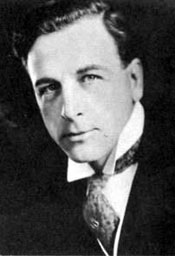  BURNING DAYLIGHT (1928 First National) 71 minutes BURNING DAYLIGHT (1928 First National) 71 minutes
In the Klondike they’ve named him Burning Daylight because of his ambitious nature. As Daylight, actor Milton Sills strikes gold and as thousands of people flock in, he builds the town of Dawson and reaps a small fortune. With his new found wealth, he and his pals (Guinn Williams and Arthur Stone) and girlfriend, Doris Kenyon, move to San Francisco hoping to extend his run of luck. Sills meets society lady Jane Winton and places his trust in her as she introduces him to the Frisco society and business world. Suspicious of Sills’ new found “friends,” Kenyon tries to warn Sills that this “new life” isn’t for him, but he turns a deaf ear. Kenyon’s advice proves accurate when Sills is the victim of a stock swindle by investment shark Edmund Breese and the self-made Alaska millionaire is wiped out. Infuriated that he’s been swindled, at gunpoint Sills regains his fortune from the tin horns and plays to return to Alaska with Doris. Expertly made, but not a traditional western, although some elements are there. Sills, born in 1882 in Chicago, was a highly successful stage actor of the early 20th Century, moving to motion pictures in 1914. In 1927, he was among 36 individuals to found the Academy of Motion Picture Arts and Sciences. Sills only made two sound films before he unexpectedly died at 48 of a heart attack in 1930 while playing tennis with his wife, Doris Kenyon who starred with him in this film, at their Santa Barbara home.
 PATSY’S JIM (1921 Irving M. Lesser) 20 minutes PATSY’S JIM (1921 Irving M. Lesser) 20 minutes
Mountie Corporal Irving Cummings assigns his pal Bud to take a prisoner to town while he goes out to see his girl, Norris Johnson. Fate steps in when the prisoner escapes and Bud is wounded. Cummings finds Bud and leaves him to recuperate at Johnson’s home while he tracks down the prisoner. When he returns Johnson has fallen in love with Bud, leaving Corp. Cummings to be consoled by Johnson’s kid sister Patsy (Irene Yaeger.) Silly nothingness, dullest of Cummings’ Mountie two-reelers.
top of page
Posted 9/28/09
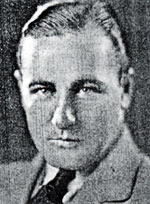   THE WILDCAT (1926 Aywon) 45 minutes THE WILDCAT (1926 Aywon) 45 minutes
Songwriter/actor Gordon Clifford was educated in Rhode Island and came to Hollywood in 1925. He was seen in only nine films before song writing became his principal interest and source of income. He wrote the lyrics to the ever-popular “I Surrender Dear” for the Bing Crosby musical short subject of the same name in 1931. “I Surrender Dear” has been heard in several films since. Another of Clifford’s hits was “Paradise” first heard in “A Woman Commands” in ‘32 and in at least four other films since then. In this mildly entertaining melodrama, prizefighter Clifford comes west to train, away from big city diversions, only to get tangled up on Charlotte Pierce and her father’s ranch with their new foreman (Irwin Renard) who turns out to be an express bandit who has hidden stolen diamonds on the ranch. Several racial slurs are uttered in the picture. Interestingly, Clifford appears as a singer, one of the Texas Two, in John Wayne’s “Paradise Canyon” (‘35). At 66, Clifford was killed in a traffic accident June 11, 1968, in Las Vegas, Nevada.
   ON THE NIGHT STAGE (1915 Mutual) 46 minutes ON THE NIGHT STAGE (1915 Mutual) 46 minutes
After robbing the stage, road agent William S. Hart comes to get his girl (Rhea Mitchell) in the saloon only to discover she’s been swayed from her wicked ways by a newly-come-to-town sky pilot (Robert Edeson). Hart challenges Edeson in a brawl but the parson bests him. Edeson and Mitchell are soon married and Hart makes peace with his initial anger over losing Mitchell but resolves to keep a watchful eye over her. When scurrilous Hershal Mayall makes lewd advances toward Mitchell, Hart drags the bounder from a stage and, in a battle, kills Mayall. The ambiguous ending has Hart alone, but feeling he’s paid a debt to the couple. Hart is billed third in his 4th film, the last time he would be other than top-star billed. The picture, rooted in 19th century melodrama, is filled with religion and redemption, themes Hart would return to again and again during his career.
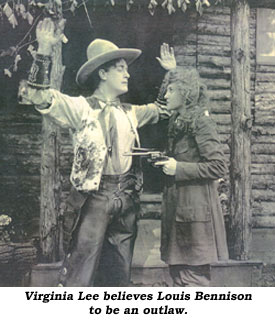  SANDY BURKE OF THE U-BAR-U (1918 Lubin/Betzwood) 55 minutes SANDY BURKE OF THE U-BAR-U (1918 Lubin/Betzwood) 55 minutes
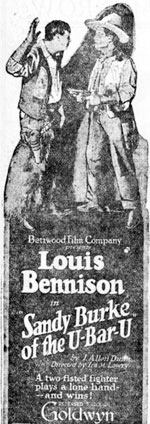 Goldwyn Studios tried to mold former stage actor Louis Bennison into a major screen star of westerns, not unlike William S. Hart. Bennison had charm and exuberance but he tended to a foppishness and was simply unconvincing as a westerner. In my LADIES OF THE WESTERNS book interview with his co-star in two westerns, Virginia Lee, she told me she introduced him to the woman Bennison quickly married. “He was such a nice guy…but he committed suicide.” (At 45 in 1929.) In this practically actionless melodrama, Bennison takes care of a young orphaned girl then meets Virginia Lee who believes him to be a wanted bandit. When it’s proven he is not, Virginia’s father hires Bennison to prevent his herd from being rustled. Simply uninvolving. This, and Bennison’s “Oh, Johnny” (‘19) were both lensed at the historic Betzwood studios, originally the 500 acre estate of wealthy brewer John Betz, across the river from Valley Forge National Park in Pennsylvania. Goldwyn Studios tried to mold former stage actor Louis Bennison into a major screen star of westerns, not unlike William S. Hart. Bennison had charm and exuberance but he tended to a foppishness and was simply unconvincing as a westerner. In my LADIES OF THE WESTERNS book interview with his co-star in two westerns, Virginia Lee, she told me she introduced him to the woman Bennison quickly married. “He was such a nice guy…but he committed suicide.” (At 45 in 1929.) In this practically actionless melodrama, Bennison takes care of a young orphaned girl then meets Virginia Lee who believes him to be a wanted bandit. When it’s proven he is not, Virginia’s father hires Bennison to prevent his herd from being rustled. Simply uninvolving. This, and Bennison’s “Oh, Johnny” (‘19) were both lensed at the historic Betzwood studios, originally the 500 acre estate of wealthy brewer John Betz, across the river from Valley Forge National Park in Pennsylvania.
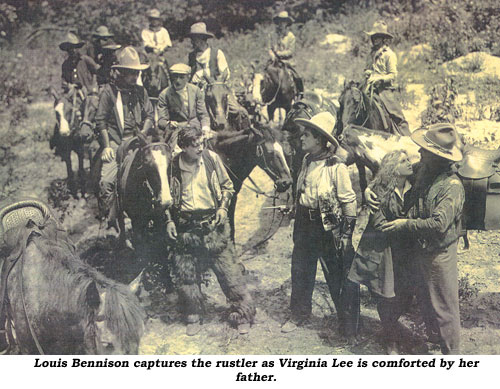
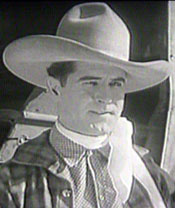     THUNDERING THOMPSON (1929 Anchor) 46 minutes THUNDERING THOMPSON (1929 Anchor) 46 minutes
Hard riding, fast moving, rip-snorter of a B-western at the tail end of the silent era. Starring the virtually forgotten Cheyenne Bill as a deputy brought in by vicious cattleman Al Ferguson on the premise of arresting sheepherder Neva Gerber and her father. But when Bill learns how Neva and Pop have been persecuted, he refuses to arrest them. Ferguson and his boys retaliate by soundly thrashing Bill and attempting to stampede Gerber’s herd. Of course, Bill intervenes—and Wow! What an action finale in the Kernville hills! Note: A white actor in blackface is cast as Bill’s friend. Cheyenne Bill, the late silent star of only 7 westerns, was born Harry William McKechnie in Sault Ste. Marie, Ontario, Canada, August 22, 1900. With no cowboy experience, he found nighttime employment with RCA in L.A. as an electrician and worked as a movie stuntman during the day (including “Beau Geste” ‘26). Morris R. Schlank of Anchor films liked his rugged good looks, tested him, and hired him to be Cheyenne Bill. Unfortunately, the coming of sound put an end to the rousing silent western era. Bill married and went to work in a quarry in Alaska. During WWII Bill was a welder and machinist and eventually wound up with the Army Transportation Service. Estranged from his family, he disappeared back to Alaska. Years later Bill and his wife settled in Seattle, WA, where he died on August 26, 1979, a week past his 79th birthday. Bill had screen presence—had he come along earlier he undoubtedly would have made a bigger mark on the silent era.
  BRONCHO BILLY’S CAPTURE (1913 Essanay) 10 minutes BRONCHO BILLY’S CAPTURE (1913 Essanay) 10 minutes
Sheriff Broncho Billy discovers Evelyn Selbie, the girl he loves (and who he thought loved him) is actually in love with stagecoach bandit Fred Church. Billy must arrest them both after a robbery. Loose remake of Essanay’s THE DEPUTY’S LOVE (1910). Terrible eye-rolling overacting here by Selbie.
top of page
Posted 7/29/09
  WANTED BY THE LAW (1924 Sunset) 51 minutes WANTED BY THE LAW (1924 Sunset) 51 minutes
For his mother’s sake, J. B. Warner takes the blame for a killing committed by his weakling kid brother and flees to Montana with his pal Frank Rice. Some time later Eastern girl Dorothy Wood arrives just as her uncle, J. Hunt, is killed by claim jumpers Jay Morley and Bill McCall. Fortunately, Warner and Rice come across Hunt as he’s dying and he entrusts his mine map to them. The plot thickens as Warner and Rice try to protect Dorothy from the thieves, all the while pursued by a Montana sheriff who has spotted Warner on a wanted poster. Written and directed with great ease and adept story telling technique by Robert North Bradbury. Cowboy cancer alert: Warner smokes.
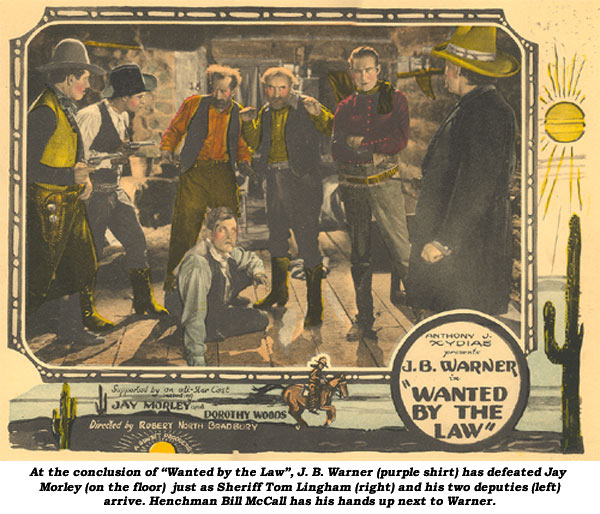
 PIONEER’S GOLD (1924 Sanford) 61 minutes PIONEER’S GOLD (1924 Sanford) 61 minutes
In a convoluted plot governed strictly by wild coincidences, a dying old rancher, Spottiswood Allen, writes two letters, sending for two people, eastern schoolmarm Kathryn McGuire, the daughter of an old flame, and long lost nephew Pete Morrison. Allen offers them his ranch and wealth when he is gone if they’ll come see the lonely old man and marry one another. Before Morrison can receive his letter, an outlaw—The Fox (Les Bates) steals the mail. Reading Allen’s letter he decides to deceive the old rancher by impersonating Morrison and grabbing off the old man’s ranch. Before he leaves, he sees to it Morrison is framed for the mail robbery and caught by the law. Meanwhile, we meet an outlaw family headed up by an ugly old crone mother with her scalawag son Merrill McCormick and beautiful but deadly daughter Virginia Warwick. Warwick decides to hold up a stage—it just so happens the one Kathryn McGuire is on. Warwick reads her letter from Allen, makes her a prisoner with her family, and goes to impersonate the schoolteacher at Allen’s ranch. Not without even more coincidental plot machinations, Morrison escapes the law, prevents the crooks from marrying, exposes the scoundrels, rescues Kathryn and makes Allen a happy old man as Pete readies to marry Kathryn. Only the muddled mind of Denver Dixon could come up with such a wild scenario so full of impossibilities. Dixon also directed, allowing for why the picture is dreadfully plot-slow with most of the action coming at the end.
   HELLHOUNDS OF THE PLAINS (1926 Goodwill) 61 minutes HELLHOUNDS OF THE PLAINS (1926 Goodwill) 61 minutes
Arizona horse thieves known as the Hellhounds are terrorizing the area with rancher Lafe McKee sustaining the heaviest losses. Unbeknownst to McKee, his disowned son, Al Ferguson (with his henchmen Bud Osborne and Cliff Lyons), is the leader of the Hellhounds. Pursued by deputy Yakima Canutt, Ferguson threatens to gun Yak unless his half sister, Neva Gerber, pays him a substantial amount of cash. Fast action start, but the midsection drags on explaining the plot. Also, there’s none of the great stuntwork we’ve come to expect from a Canutt western. Midway, Yak makes a racial slur against a black cook (played by a white actor in blackface.).
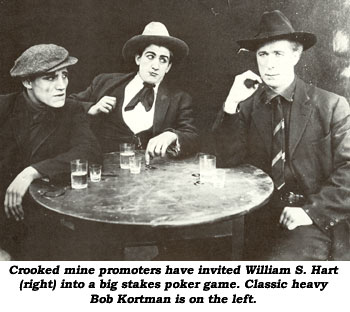   THE RUSE (1915, Kay-Bee, New York Motion Picture Co.) 18 minutes THE RUSE (1915, Kay-Bee, New York Motion Picture Co.) 18 minutes
The New York Motion Picture Company was founded by two ex-bookmakers, Adam Kessel and Charles Baumann, who scented $$$ in the burgeoning movie business. In no time at all they were independently producing pictures under a variety of trade names. William S. Hart’s producer, Thomas H. Ince, was working in Los Angeles for the New York Motion Picture Company when Hart left the NY stage in 1914 in favor of movies. Ince formed a distribution deal with Kessel and Baumann and Hart’s first two-reeler, “His Hour of Manhood”, was released in July 1914. In “The Ruse” Hart is a westerner who goes to Chicago to sell his gold claim. Unfortunately, he becomes linked up with crooked mine promoter Jack Davidson. One of Hart’s later two-reelers is, granted, not one of his best, but even so it shows how much story and plot can be detailed in a brief 18 minutes using camera angles and editing as exacting as those of 30-40 years later.
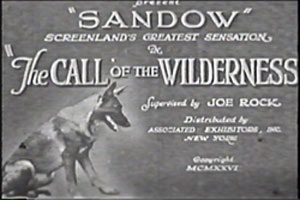  CALL OF THE WILDERNESS (1926 Associated Exhibitors) 57 minutes CALL OF THE WILDERNESS (1926 Associated Exhibitors) 57 minutes
With Rin Tin Tin a star, every studio in Hollywood needed a dog star, turning the ‘20s into the decade of the heroic German Shepherd picture. Here, Sandow, billed as “The World’s Greatest Dog”, is the friend of eastern playboy Lewis Sargent whose father, tired of his wild escapades, sends his son away to “make a man of yourself.” Heading west, Sargent and Sandow wind up in Newhall, CA (obviously filmed there due to all the store signs). Sargent promptly becomes smitten with the land agent’s daughter, Edna Marion. To impress her, he purchases a homestead on which villainous prospector Al Smith has just found gold but hasn’t registered the mineral rights. When Smith attempts to kill Sargent, Sandow wreaks revenge. Very slow going with little action and drastically hampered by the strong racial slurs aimed at a white actor in blackface (“culluh boy”, “niggah”) midway through the film. Sandow’s fame was fleeting, he only was featured in two others, “Code of the Northwest” (‘26) and “Avenging Fangs” (‘27).
top of page
Posted 6/26/09
  WITH DANIEL BOONE THRU THE WILDERNESS (1926 Sunset) 59 minutes WITH DANIEL BOONE THRU THE WILDERNESS (1926 Sunset) 59 minutes
By 1926 Roy Stewart was an established western star, originally groomed at Triangle as a replacement for William S. Hart. Through the years he also starred in westerns for Universal, Hodkinson, Arrow and FBO, among others. Unfortunately, nearly all these are lost to the ages and we are left to judge Stewart by his low-budget romanticized historical westerns done for Anthony J. Xydia’s Sunset Productions in ‘25-‘26, this one directed by Robert North Bradbury who utilized his young son Bob Bradbury Jr. in the role of leading lady Kathleen Collins’ brother. Bob was in his junior year of high school but quit to pursue a film career with his Dad. As we know, he succeeded quite well as Bob Steele. Centered around the time of Boone’s moving to Kentucky, it is told here the reason for the move was because he believed his girl (Collins) was in love with another man (Edward Hearn). Turns out Hearn is Collins’ older brother and Boone and the girl are reunited just as Indians led by renegade white man Jay Morley strike! The film was probably geared toward an adult audience as the scene where Collins is nearly raped by Morley is very strong for 1926. Bob (Steele), although not credited on the lobby card shown here, has a surprisingly large role as Collins’ kid brother and features in many of the action sequences. Film’s main drawback is some romantic and family oriented meandering midway.
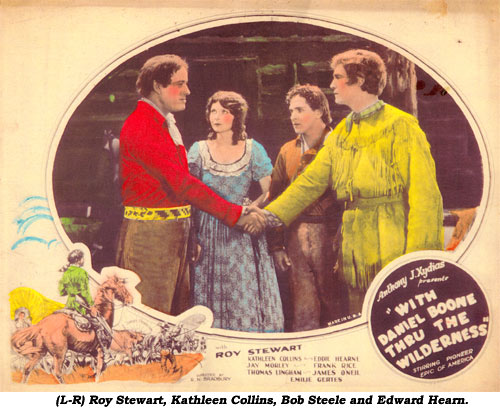
  WOLFHEART’S REVENGE (1925 Aywon) 43 minutes WOLFHEART’S REVENGE (1925 Aywon) 43 minutes
Cattle rancher Captain Bingham sends his unscrupulous foreman Larry Fischer to buy some water rights from a neighboring sheepherder. When the sheepman rejects the offer, Fischer ambushes the herder and plants a $5,000 check on him making it appear he sold before he was killed. All this skullduggery is witnessed by Big Boy Williams’ faithful dog Wolfheart, so Fischer frames Big for cattle rustling. Kathleen Collins is the eastern girl visiting her Uncle Bingham who falls for Williams. Strictly routine.
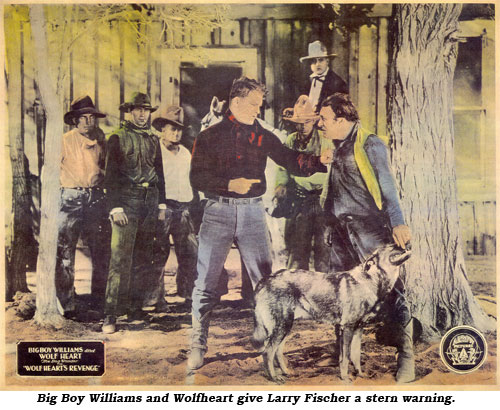
 BILL HAYWOOD, PRODUCER (1915 Selig) 11 minutes BILL HAYWOOD, PRODUCER (1915 Selig) 11 minutes
Things go awry when cowpuncher Tom Mix tries his hand at movin’ pictures. Tame comic western in which much of the humor is lost in too many long shots.
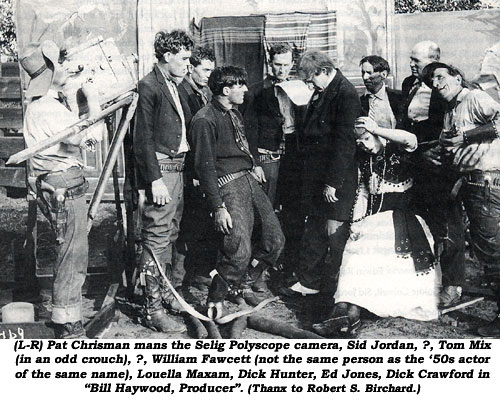
   WARNED IN ADVANCE (1923 Pathé) 22 minutes WARNED IN ADVANCE (1923 Pathé) 22 minutes
What a merry mixup…a real western who’s who farce, and all in 22 fast-paced minutes as Leo Maloney and Josephine Hill plan to get married. Whoops! Her father’s hot on their trail! Meanwhile, pals Bud Osborne and Barney Furey are two just-pardoned cons out for revenge on Judge Nelson McDowell, the very judge who’s going to marry Maloney and Hill. The badmen believe Hill is the Judge’s daughter while the Judge believes they are after his real daughter who is set to arrive on the stage. Grand fun all the way!
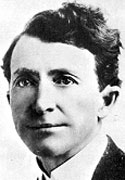   WHEN OUTLAWS MEET (1920 Capital) 21 minutes WHEN OUTLAWS MEET (1920 Capital) 21 minutes
Minor real-life outlaw Al Jennings was pardoned by President Theodore Roosevelt in 1904. Al had been sentenced to life in prison in the late 1890s for blowing up a train’s U. S. mail car while trying to open the safe. His take resulted in a paltry $12.60. Pardoned, he once again took up the law books in Oklahoma, as he had before his outlawry. His tall tales of the real west eventually brought Al to Hollywood in 1907 where a film based on his life was made. Electing to become an actor himself in 1917, in 1919-‘20 Capital starred Al in a poverty-row series of two-reelers. Here outlaws Al and Slim are suspected of being “revonoors” when they stop in to panhandle a bite to eat at a bootlegger’s cabin. Wounded in a gunfight, Al takes refuge with some Cherokee Indians. Pursued by two U. S. Marshals, the windup confuses but, basically, Al escapes with his bootlegger’s daughter-girlfriend. Huh? After the series for Capital, Al drifted into occasional character roles. He died at 98 in 1962. The scrawny little Al just didn’t possess the right stuff to be a leading man. (For the full story on Jennings, read Bill Russell’s column in our WESTERN CLIPPINGS #74, Nov.-Dec. ‘06.)
    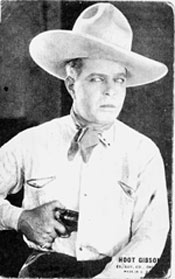 FIGHT IT OUT (1920 Universal) 20 minutes FIGHT IT OUT (1920 Universal) 20 minutes
After service in WWI, Hoot Gibson began starring in his own series of Universal two-reelers in late 1919 after playing second lead to Pete Morrison and Jack Perrin in nearly a dozen. He assumed the role of a hearty, lighthearted, smart but often naïve or comedic young westerner, the antithesis of other grim screen westerners. Hoot dared to be human, realistic, often dressed like a dude, and soon found his way into the hearts of western fans. Here, happy-go-lucky Hoot finds ranch owner Charles Newton and daughter Dorothy Wood feuding with unruly neighbor Jim Corey over water rights. When Corey and henchman Ben Corbett attempt to frame Newton for rustling, Hooter turns the tables on them and ends up getting the badmen to fight among themselves. Pure Hoot Gibson with high quality production values as usually associated with Universal who made the best silent westerns.
top of page
|

